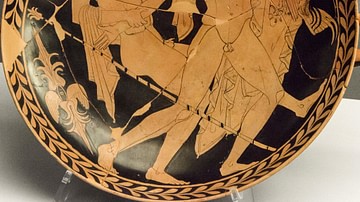Search
Search Results

Video
The Egyptian Myth of the Death of Osiris - Alex Gendler
Dig into the Egyptian myth of Osiris, trapped by his brother, the warrior god Set, in a coffin and tossed into the Nile to die. Long jealous of his older brother Osiris, the god who ruled all of Egypt, the warrior god Set plotted to overthrow...

Video
Spirits: The Dís and Fylgja in Norse Myth
Most of our sources for Norse myth tell of gods and great heroes, but constant references in the sagas also reveal a belief in spirits called dís (plural dísir) and fylgja (plural fylgjur) that we only vaguely understand today. This is a...

Video
Misunderstood Moments in History - The Spartan Myth
Start your 30 day free trial here: http://ow.ly/eCd230fiZ7Q The Spartans are immortalized in history as super soldiers bred for war. However most of what we think we know about them is a lie. Today we will unmask the truth behind the Spartan...

Video
Modoc Origin Myth
A narration of a Modoc origin myth.

Video
The Saint Sophia Cathedral | Kyiv's Architecture: History And Myth
We continue our architectural series with a story about one of Kyiv's most breath-catching sights. The Saint Sophia Cathedral. A UNESCO world heritage sight, the church complex held its first service around a millenium ago. _ Subscribe...

Video
What Is Myth? Crash Course World Mythology #1
Welcome to Crash Course World Mythology, our latest adventure (and this series may be literally adventurous) in education. Over the next 40 episodes or so, we and Mike Rugnetta are going to learn about the world by looking at the foundational...

Video
The Myth of Jason and the Argonauts
Download a free audiobook version of "Circe" and support TED-Ed's nonprofit mission: https://www.audible.com/ted-ed Check out our full book recommendation: https://shop.ed.ted.com/collections/ted-ed-book-recommendations/products/circe...

Video
The myth of Jason and the Argonauts - Iseult Gillespie
Hercules, the strongest man alive with a mighty heart to match. Orpheus, charmer of nature and master of music. Castor and Pollux, the twin tricksters. The Boreads, sons of the North Wind who could hurtle through the air. Brought together...

Definition
Cuneiform
Cuneiform is a system of writing first developed by the ancient Sumerians of Mesopotamia c. 3500 BCE. It is considered the most significant among the many cultural contributions of the Sumerians and the greatest among those of the Sumerian...

Definition
Ganymede
Ganymede (pronounced GAH-nuh-meed) is a youth in Greek mythology who is abducted by Zeus because of his great beauty and brought to Mount Olympus to serve as cupbearer. The story first appears in Homer’s Iliad without any suggestion of a...